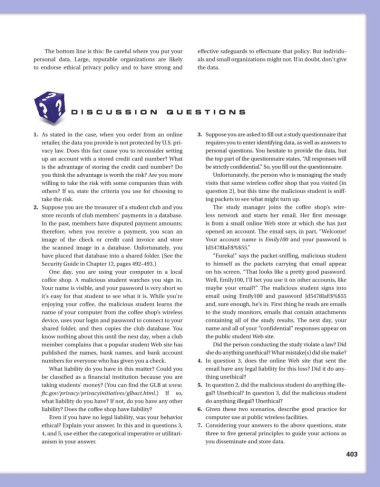Page 435 - Using MIS
P. 435
The bottom line is this: Be careful where you put your effective safeguards to effectuate that policy. But individu-
personal data. Large, reputable organizations are likely als and small organizations might not. If in doubt, don’t give
to endorse ethical privacy policy and to have strong and the data.
DisCussion Questions
1. As stated in the case, when you order from an online 3. Suppose you are asked to fill out a study questionnaire that
retailer, the data you provide is not protected by U.S. pri- requires you to enter identifying data, as well as answers to
vacy law. Does this fact cause you to reconsider setting personal questions. You hesitate to provide the data, but
up an account with a stored credit card number? What the top part of the questionnaire states, “All responses will
is the advantage of storing the credit card number? Do be strictly confidential.” So, you fill out the questionnaire.
you think the advantage is worth the risk? Are you more Unfortunately, the person who is managing the study
willing to take the risk with some companies than with visits that same wireless coffee shop that you visited (in
others? If so, state the criteria you use for choosing to question 2), but this time the malicious student is sniff-
take the risk. ing packets to see what might turn up.
2. Suppose you are the treasurer of a student club and you The study manager joins the coffee shop’s wire-
store records of club members’ payments in a database. less network and starts her email. Her first message
In the past, members have disputed payment amounts; is from a small online Web store at which she has just
therefore, when you receive a payment, you scan an opened an account. The email says, in part, “Welcome!
image of the check or credit card invoice and store Your account name is Emily100 and your password is
the scanned image in a database. Unfortunately, you Jd5478IaE$%$55.”
have placed that database into a shared folder. (See the “Eureka!” says the packet-sniffing, malicious student
Security Guide in Chapter 12, pages 492–493.) to himself as the packets carrying that email appear
One day, you are using your computer in a local on his screen. “That looks like a pretty good password.
coffee shop. A malicious student watches you sign in. Well, Emily100, I’ll bet you use it on other accounts, like
Your name is visible, and your password is very short so maybe your email?” The malicious student signs into
it’s easy for that student to see what it is. While you’re email using Emily100 and password Jd5478IaE$%$55
enjoying your coffee, the malicious student learns the and, sure enough, he’s in. First thing he reads are emails
name of your computer from the coffee shop’s wireless to the study monitors, emails that contain attachments
device, uses your login and password to connect to your containing all of the study results. The next day, your
shared folder, and then copies the club database. You name and all of your “confidential” responses appear on
know nothing about this until the next day, when a club the public student Web site.
member complains that a popular student Web site has Did the person conducting the study violate a law? Did
published the names, bank names, and bank account she do anything unethical? What mistake(s) did she make?
numbers for everyone who has given you a check. 4. In question 3, does the online Web site that sent the
What liability do you have in this matter? Could you email have any legal liability for this loss? Did it do any-
be classified as a financial institution because you are thing unethical?
taking students’ money? (You can find the GLB at www. 5. In question 2, did the malicious student do anything ille-
ftc.gov/privacy/privacyinitiatives/glbact.html.) If so, gal? Unethical? In question 3, did the malicious student
what liability do you have? If not, do you have any other do anything illegal? Unethical?
liability? Does the coffee shop have liability? 6. Given these two scenarios, describe good practice for
Even if you have no legal liability, was your behavior computer use at public wireless facilities.
ethical? Explain your answer. In this and in questions 3, 7. Considering your answers to the above questions, state
4, and 5, use either the categorical imperative or utilitari- three to five general principles to guide your actions as
anism in your answer. you disseminate and store data.
403

